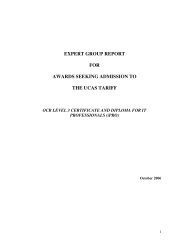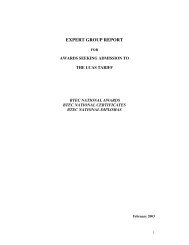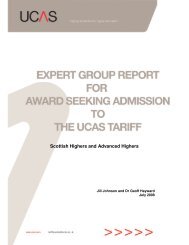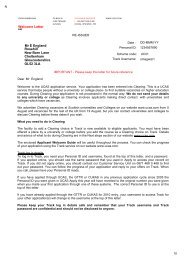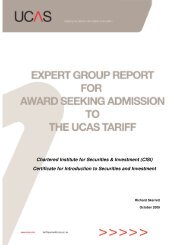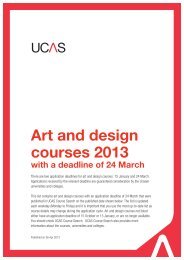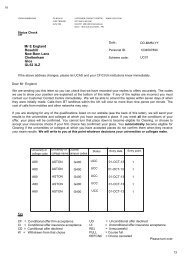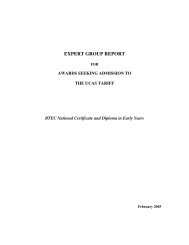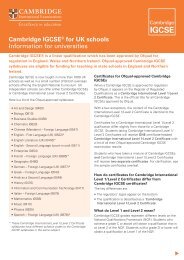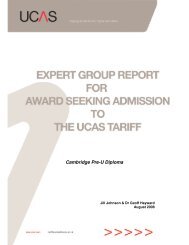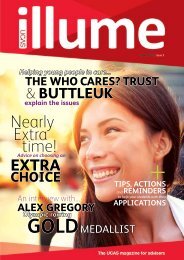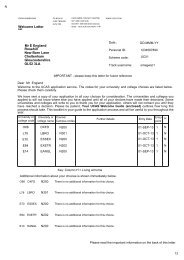International qualifications 2013 (pdf) - CUKAS
International qualifications 2013 (pdf) - CUKAS
International qualifications 2013 (pdf) - CUKAS
Create successful ePaper yourself
Turn your PDF publications into a flip-book with our unique Google optimized e-Paper software.
Qualifications currently offered<br />
Admission based on first term grade 12 marks. The average<br />
calculation includes English, mathematics and three acceptable<br />
academic subjects. The University of Regina uses an Early<br />
Conditional Admission Average (combination of grade 11 and<br />
12 grades) which ranges between 65% - 85% depending on<br />
the faculty/programme to which a student is applying. Students<br />
must present a minimum number of approved high school<br />
courses for admission consideration. The number of courses<br />
required will vary by province/territory.<br />
Yukon (YK)<br />
Yukon uses the BC curriculum and graduation requirements<br />
established by that province. Admission requirements vary<br />
between programmes. The general admissions criteria for<br />
acceptance into post-secondary studies are completion of<br />
academic grade 12 including grade 12 English and grade 11<br />
mathematics. Admission to some programmes that have<br />
enrolment limits may require competitive marks higher than the<br />
minimum admission requirements set out in the academic<br />
calendar. Mature applicants who do not meet normal admission<br />
requirements may be eligible through consideration of other<br />
<strong>qualifications</strong> and/or assessments.<br />
China<br />
EVALUATION<br />
Senior High School Entrance Examination (Chuzhong Huikao)<br />
Considered to be between GCSE and GCE A level standard. Those<br />
students with high grades may be considered for admission to<br />
access or foundation level programmes.<br />
Vocational Secondary School Diploma (Zhixiao)<br />
Considered to be comparable to BTEC First Diploma/NVQ<br />
level 2.<br />
University Entrance Examination (Gaokao)<br />
Considered to be between AS and A2 level standard. It is<br />
generally considered more advanced than the Senior High School<br />
Examination. Those students with high grades may be considered<br />
for admission to access or foundation level programmes.<br />
GRADING SYSTEM<br />
Senior High School Examination<br />
Nine subjects are taken and graded A–D (with A being the highest).<br />
A 100 – 80%<br />
B 79 – 70<br />
C 69 – 60<br />
D<br />
Fail<br />
University Entrance Examination<br />
The examination includes three core subjects, each of which is<br />
marked out of 150 points, and a comprehensive subject (arts<br />
route or science route) with 300 points maximum, adding up to a<br />
total score of 750 for the examination.<br />
EDUCATION SYSTEM<br />
Primary and secondary education in China comprises three<br />
stages: six years of primary school, three years of junior middle<br />
school, and three years of senior middle school. Primary and<br />
junior middle school education is compulsory, and commences<br />
at age six. To progress from junior middle school, students must<br />
pass locally organised entrance examinations. Results of these<br />
entrance examinations are used to stream students into a general<br />
academic route or a technical and vocational route.<br />
The technical and vocational schools offer the Vocational<br />
Secondary School Diploma which includes general knowledge,<br />
basic technology and a subject specialism. Senior secondary<br />
schools offer the Senior High School Entrance Examination, which<br />
is usually taken in five or six subjects. As it is taken across the<br />
country, but organised on a provincial basis, curricula and<br />
standards may vary.<br />
ACCESS TO HIGHER EDUCATION<br />
Graduation from Senior Secondary School is a prerequisite for<br />
sitting the University Entrance Examination. The upper age limit of<br />
25 was abolished in 2001. The University Entrance Examination<br />
format can vary between provinces, but is taken nationwide.<br />
There are three compulsory core subjects, namely Chinese,<br />
mathematics and a foreign language (English, Japanese, Russian,<br />
French, German or Spanish). In addition, students need to take a<br />
test on a comprehensive subject which is basically a combination<br />
of three courses: biology, chemistry and physics for science route<br />
students; and politics, geography, and history for arts route<br />
students. Specific examination arrangements may be organized<br />
by the local government according to their existing policies.<br />
HE is structured into four-year bachelor’s programmes (xueshi),<br />
two to three-year master’s programmes (shuoshi) and three to<br />
five-year Doctorates (boshi).<br />
Croatia<br />
EVALUATION<br />
State Matura (secondary school leaving qualification) State<br />
Matura (Državna matura) was introduced in Croatia in<br />
2009/2010. It is taken in three compulsory subjects (Croatian,<br />
mathematics and a foreign language), which can be taken at an<br />
advanced (A) or basic (B) level, and one or more optional subjects<br />
(no more than six). The examinations are conducted by the<br />
National Centre for External Evaluation of Education. It<br />
isacceptable as a group qualification satisfying general entrance<br />
requirements.<br />
Medjunarodna Matura (<strong>International</strong> Baccalaureate)<br />
A baccalaureate style qualification offered by some grammar<br />
schools (gimnazija) in Croatia, which satisfies the general entry<br />
requirements for UK HE.<br />
GRADING SYSTEM<br />
5 Excellent<br />
4 Very Good<br />
3 Good<br />
2 Sufficient<br />
1 Fail<br />
EDUCATION SYSTEM<br />
Eight years of primary education, with a foreign language<br />
introduced in year one, are usually followed by one of<br />
the following:<br />
g<br />
g<br />
g<br />
g<br />
Four-year grammar schools (gimnazija), which may be<br />
classified as general, linguistic, classical or scientific, with<br />
appropriately different curricula.<br />
Four-year art schools (art and design, music, dance).<br />
Four-year vocational schools (engineering, healthcare,<br />
economics, agriculture, etc).<br />
Three-year vocational schools (industrial, crafts, etc).<br />
Apart from IB programmes, where the language of instruction is<br />
English, the language of instruction in all other schools is Croatian.<br />
INTERNATIONAL QUALIFICATIONS 15



